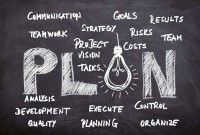- Home
- Business Processes
- Industry Knowledge
- Aerospace Industry
- Automotive Industry
- Banking Domain
- BFSI Industry
- Consumer/ FMCG Industry
- Chemicals Industry
- Engineering & Construction
- Energy Industry
- Education Domain
- Finance Domain
- Hospitality Domain
- Healthcare Industry
- Insurance Domain
- Retail Industry
- Travel and Tourism Domain
- Telecom Industry
- Leadership Skills
- eLearning
- Home
- Leadership
- Communication Skills
- Definition of Leadership
Definition of Leadership
Leadership has been defined in different ways by different sets of scholars. In very simple terms leadership can be defined as the skill of a person to influence an individual or a group for achievement of a goal in a given situation. One can use different dimensions and perspectives to define leadership. Through the evolution of leadership thought, leadership has been defined in various ways discussed here.
“A leader is one who has followers”; is a too simple a definition and this description does not clearly define what other attributes are associated with leadership. One can use different dimensions and perspectives to define leadership. Through the evolution of leadership thought, leadership has been defined in various ways with following perspectives:
- Group Processes
- Personality Perspective
- Behavioral Traits
- Power Relationships
- Process perspective
- Skills perspective
Definitions of Leadership
According to MacIver and Page Leadership is the capacity to persuade or to direct man that comes from personal qualities apart from office. It indicates the difference between leadership and office. An individual does not become a leader only by occupying an office which carries responsibility. It is a matter of secondary importance that his important office is of assistance to him in his endeavor to become a leader.
According to Philip A. Woods (2005) leadership is not just a set of free-standing actions i.e., it is not a linear process flowing from leader to the follower but it is a collective entity which comprises of the impetus and direction that emerges from the group which is more than the sum of its parts (the individuals) who make up a group or organization. .
Warren Bennis’ definition of leadership is focused much more on the individual capability of the leader. He defined leadership as a function of knowing oneself, having a vision that is well communicated, building trust among colleagues, and taking effective action to realize one’s own leadership potential.
Leadership can also be called the catalyst that transforms potential into reality. The concept of leadership in itself covers all interpersonal relationships that influence the working of' the organization towards achieving its business objectives and growth.
Leadership is the art of influencing others to direct their will, abilities and efforts to the achievement of leader’s goals. In the context of organizations, leadership lies in influencing individual and group effort toward the optimum achievement of organizational objectives.
Keith Davis observes that, “without leadership, an organization is but a muddle of men and machines…Leadership transforms potential into reality. It is the ultimate act which brings to success all the potential that is in an organization and its people”.
Leadership is often defined as the art of influencing others (people) to strive willingly; to do what the leader wants them to do (often to do the mutually compatible objectives) with zeal and confidence.
According to Dayal (1999) leadership is development of people, not the task. A leader creates conditions for the development of individuality and enhancement of inherent capability of individuals.
The leader is the inspiration and director of the action. He is the person in the group that possesses the combination of personality and leadership skills that makes others want to follow his direction.
Leadership focuses on “people” aspect of management and is based on the assumption that organizational effectiveness significantly depends on their motivation, effort and abilities.
According to Pigors, “Leadership is a process of control in which by the assumption of superiority a person or group regulates the activities of others for purposes of his own choosing.”
In 1938, Chester Bernard gave a new definition of leadership and stated that, “leadership is the ability of a superior to influence the behaviour of subordinates and persuade them to follow a particular course of action”.
A recent theorist on leadership, Williams (2005), states that, “leadership is an interactive art in which the leader is dancing with the context, the problem, the faction, and the objective”.
It is encouraging and inspiring individuals and teams to give their best to achieve a desired result.
Leadership is an attribute of the person who is an ideal for the other members of the group.
Leadership is the behavior that affects the behavior of other people, more than their behavior affects that of the leader.
Leaders work with and through people to accomplish goals.
In the 21 Irrefutable Laws of Leadership, John Maxwell sums up his definition of leadership as “leadership is influence - nothing more, nothing less.”
Anyone who acts as a model to others is often called a “leader”.
Leader leads, suggests, orders, and also guides. Other people follow him. We can say that leadership and domination are not the same meaning.
Peter Drucker defined a leader as someone who has followers.
What is the best definition of leadership?
It is difficult to qualitatively define leadership. Leadership involves various dimensions and attributes. A simple definition of leadership is that leadership is the art of motivating a group of people to act towards achieving a common goal. It is a psychological process of providing guidance for followers. To lead is to guide, conduct, direct, and proceed.
Related Links
You May Also Like
-
Tools for Developing Your Team
If a manager has too many weak spots in the talent of the team, the ability to empower the team members to independently execute the project is impaired. Assignments fall behind schedule or stretch out because the needed skills or knowledge are not in place when needed. To successfully execute important projects, hiring talented people, and increasing the talents of existing staff are most important.
-
Managers have to perform many roles in an organization, and how they handle various situations will depend on their style of management. Management styles are the characteristic ways, of making decisions relating to subordinates. These are the strategies, efforts, or direction used by the manager, to create an efficient workplace, to achieve organizational goals. A management style is the method of leadership used by a manager.
-
In today's business world, proficiency in management skills is essential for career growth and success. Managerial skills can be defined as attributes or abilities that are essential for every leader and manager to succeed and fulfill specific tasks expected from them by the organization.
-
The development of teams is an ongoing process because the composition of the team may keep on changing. The new members may join and the old members may leave the team. The team members pass through several stages for the development of the team and there has been a lot of research to identify these stages. In this article, we discuss the common theories of team development.
-
Administrative Theory by Fayol
The administrative theory of management is focused on principles that could be used by managers to coordinate the internal activities of organizations. The most prominent of the administrative theorists was Henri Fayol. Fayol observed a work stoppage and judged it to be a management failure. He believed that organizational managerial practices are important for driving predictability and efficiency in organizations.
-
There are four characteristics of leadership that help us to understand the character of leadership as a concept. 1. Leadership is a process, 2. Leadership involves influence, 3. Leadership always occurs in a group context and 4. Leadership involves goal attainment. These are the four components that make up the character of the 'leadership' term and help us to define the leadership concept. All of these components of leadership have common characteristics.
-
Have you ever resonated that there seem to be as many different ways to lead people as there have been great leaders? When we recall the success of Mahatma Gandhi, Nelson Mandela, Abraham Lincoln, Napoleon Bonaparte to Steve Jobs and Jack Welch, we also notice that they all used different approaches that were suitable to their specific situations and circumstances. Over the last century, researchers and psychologists have developed simple ways to describe the “Styles of leadership” and in this section, we will explore these commonly known leadership styles.
-
In this study of power, Raven identified five bases of power as coercive, reward, legitimate, referent, and expert. The 5 Types of Power can help you decide when it is appropriate to use a particular type of power in important situations. Leadership involves authority and it is very important for leaders to understand what type of power they're using.
-
Modern Approaches to Management
The modern approaches to management look at organizational management in the current context. They take a holistic approach and look at organizations as a collection of interrelated parts influenced by both internal dynamics and also the larger external environment. These modern management theories have played a significant role in the evolution of management studies.
-
Behavioral Approach to Management
The behavioral management theory had a profound influence on management by focusing on understanding the human dimensions of work. It is also called human relations movement as behavioral theorists focused on managing productivity by understanding factors of worker motivation like their needs and expectations, personality, attitudes, values, group behavior, conflict, and group dynamics. It advocated the use of psychological techniques to motivate employees.
Explore Our Free Training Articles or
Sign Up to Start With Our eLearning Courses

About Us
Learning
© 2023 TechnoFunc, All Rights Reserved










